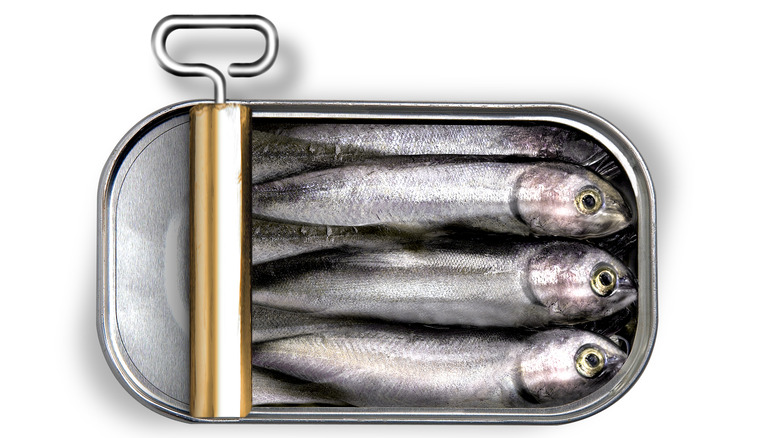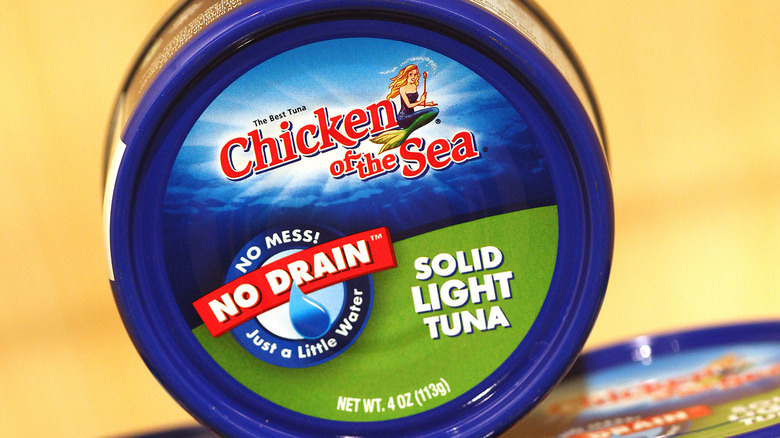How A Sardine Shortage Made Canned Tuna Possible
It's fair to say that the U.S. was much more of a "meat and potatoes" kind of place a century or so ago, with your average consumer annually taking in about 60 pounds each of meat lover staples like beef and pork and 15 pounds of chicken, yet less than seven pounds of fish, according to the Washington Post. Today's fish figures have greatly improved, hovering around 19 pounds per person (even though many of those options are often breaded or fried).
In fact, you might be surprised to know that, before the early 1900s, one of the most popular kinds, tuna, was less of a typical pantry item and used more as fertilizer (via ResearchGate). According to Trevor Corson, the writer behind "The Story of Sushi," as quoted by the Washington Post article, tuna at that time was even considered a "trash fish" in the United States — one which couldn't hold a candle to the booming sardine industry. After all, sardines were seafood for the masses, says The Atlantic — the dock workers, the assembly line proles, the military for whom it was served whole, with bones, oil, and all.
With the increased popularity, the problem of overfishing happened, and by 1903, canneries once spoiled by the bounty of sardines began looking for alternatives as reserves dried up. Halibut and rock fish had their brief times in the limelight, but albacore tuna became the real hit due to this shortage (per Atuna). Subsequently, Albert Halfill — a canner dubbed the "sardine man" — figured out that steaming albacore tuna not only gave it a more approachable "whiter" color (like chicken meat), but also a relatively mild flavor. Thus, the "chicken of the sea" was born, simultaneously catalyzing a nationwide decline in sardine consumption. And, eventually, tuna sales finally surpassed sardines.
Tuna soon became the top seller in America
Since the introduction of canned tuna in 1904, per Washington Post, it's been a huge hit and has taken over the canned fish market that was once dominated by sardines. Though, we have learned a great deal about the benefits — and a couple of flaws — of eating the pelagic fish. Whereas tuna is a low-fat, high-protein dish that has a fair amount of Omega-3 fatty acids (a type of polyunsaturated fat that could be beneficial to building cell walls and good heart health), it may also be dangerous if eaten in excess. Just ask actor Jeremy Piven about his opinion on mercury poisoning. The element is naturally dissolved into seawater, and is then absorbed by small sea creatures. And when tuna infamously snack on those creatures, they take on that store of mercury, which can then pass onto us (per Healthline).
In the pro-sardine camp, other studies have shown that, compared to tuna, sardines may be healthier for us to eat, providing more heart-healthy Omega-3 fatty acids. Furthermore, from a more somber perspective, since tuna generally live up to 10 years and sardines up to six years, that makes sardines less likely to regale us with any toxins that they might have slurped up over longer periods of time (via The Atlantic).
Ironically, as if history had nothing better to do than repeat itself, worldwide albacore tuna populations are now shrinking due to unsustainable fishing methods; as usual, the U.S. isn't exempt, having almost entirely depleted its Pacific tuna numbers in the 1930s. So, what might canners think of next? Just please don't say watermelon.

